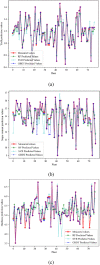An integrated learning algorithm for early prediction of melon harvest
- PMID: 36307511
- PMCID: PMC9616828
- DOI: 10.1038/s41598-022-20799-z
An integrated learning algorithm for early prediction of melon harvest
Abstract
Different modeling techniques must be applied to manage production and statistical estimation to predict the expected harvest. By calculating advanced production methods and the rational valuation of different factors, we can accurately capture the variety of growth characteristics and the expected yield. This paper obtained 32 feature variables related to melons, including phenological features, shape features, and color features. The Gradient Boosted Decision Tree (GBDT) network and the Grid Search (GS) hyperparameter seeking method was applied to calculate the degree of importance of all melon fruits' characteristics and construct prediction models for three expected harvest indexes of melon yield, sugar content, and endocarp hardness. To facilitate growers to carry out prediction and estimation in the field without destroying the melon fruits. The reduced feature variables were selected as inputs. The GBDT model was used to provide a significant advantage in prediction compared to both Random Forest (RF) and Support Vector Regression (SVR) methods. In addition, to verify the feasibility of using only reduced feature variables as input for the evaluation work, this study also compares the predictive effects of the model when all feature variables and only reduced feature variables are used. The GBDT prediction model proposed in this paper predicted melon yield, sugar content, and hardness using reduced features as input, and the model R2 could reach more than 90%. Therefore, this method can effectively help growers carry out early non-destructive inspection and growth prediction of melons in the field.
© 2022. The Author(s).
Conflict of interest statement
The authors declare no competing interests.
Figures






Similar articles
-
Non-destructive sugar content assessment of multiple cultivars of melons by dielectric properties.J Sci Food Agric. 2021 Aug 15;101(10):4308-4314. doi: 10.1002/jsfa.11070. Epub 2021 Jan 20. J Sci Food Agric. 2021. PMID: 33417254
-
[Effects of grafting and nitrogen fertilization on melon yield and nitrogen uptake and utilization].Ying Yong Sheng Tai Xue Bao. 2017 Jun 18;28(6):1909-1916. doi: 10.13287/j.1001-9332.201706.004. Ying Yong Sheng Tai Xue Bao. 2017. PMID: 29745153 Chinese.
-
Enhanced wave overtopping simulation at vertical breakwaters using machine learning algorithms.PLoS One. 2023 Aug 16;18(8):e0289318. doi: 10.1371/journal.pone.0289318. eCollection 2023. PLoS One. 2023. PMID: 37585387 Free PMC article.
-
Research on a Gas Concentration Prediction Algorithm Based on Stacking.Sensors (Basel). 2021 Feb 25;21(5):1597. doi: 10.3390/s21051597. Sensors (Basel). 2021. PMID: 33668797 Free PMC article.
-
Melon fruits: genetic diversity, physiology, and biotechnology features.Crit Rev Biotechnol. 2008;28(1):13-55. doi: 10.1080/07388550801891111. Crit Rev Biotechnol. 2008. PMID: 18322855 Review.
References
-
- Sun, L. X., Wang, X. J., Wu, J. X. & Mao, S. P. Research on regional distribution changes and driving factors of watermelon and melon production in China. Chin. J. Agric. Resour. Region. Plan. https://kns.cnki.net/kcms/detail/11.3513.S.20220705.1954.008.html. (2022).
-
- Wang K. High efficient cultivation techniques of muskmelon in winter and spring in solar. J. Agric. Catastrophol. 2021;11(3):1.
-
- Sun JT. Study on Nondestructive Dection of Hami Melon Maturity Based on Information Fusion of Spectrum and Image. Shihezi University; 2017.
-
- Lv C, et al. Research progress of melon ripeness detection technology. Jiangsu Agric. Sci. 2014;42(1):244–246.
Publication types
MeSH terms
Substances
Grants and funding
LinkOut - more resources
Full Text Sources

